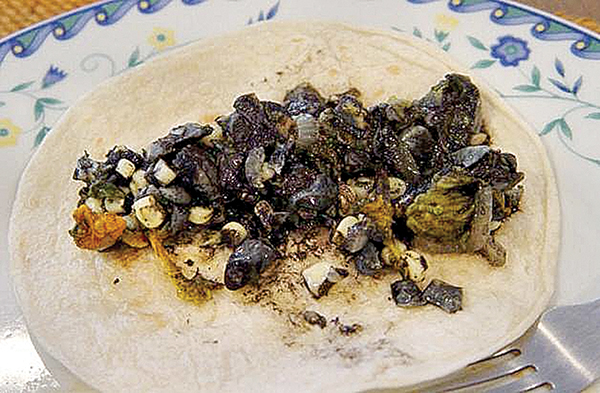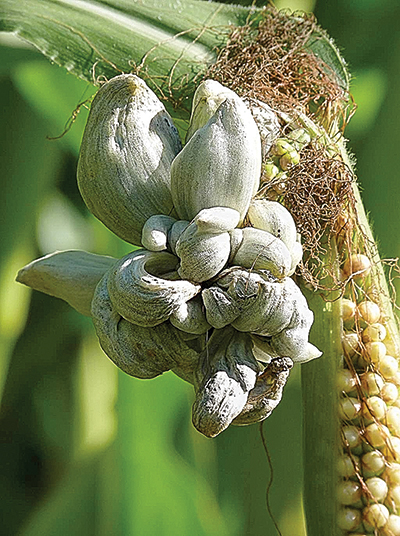

Ken Springer
Contributing Writer
A smutty story about a Corny Fungus
“Those who enjoy eating are making the most out of one of life’s necessities.” ~ Sign over the entrance to a Filipino bakery in Honolulu.
Eduardo tossed back a small cup of sweet, dark coffee like a shot of tequila. He had left his house in Central Mexico just as the rising sun had backlit the rugged peaks of the Sierra Madres to the east.
He headed straight for his cornfields, carrying his tools in a pack. Like all mornings, Eduardo’s mission this morning was to enter his fields and locate a parasitic fungus infecting his corn.
Contrary to what we may assume, Eduardo was not out to eliminate the parasite but to encourage its growth.
Why? you ask.
As unpalatable as the tumor-like growths look, they are a highly sought-after delicacy, and their price reflects their popularity. An ear of corn infected with huitlacoche commands a price up to 40 times more than an uninfected ear.
This parasitic fungus is called huitlacoche in Spanish (pronounced “wheat la coacheh”), corn must in English, and to mycologists, Mycosarcoma maydis.
Much as the Oak Apple Gall wasp secretes a compound that modifies the regular oak leaf pattern into a sphere to protect and feed its larvae, corn smut turns individual kernels of corn into enlarged bluish-white galls that taste delicious.
Huitlacoche naturally affects approximately two percent of corn crops due to the spore released by the mature fungus, so one should expect to find only two infected ears out of a hundred.
Time is of the essence in collecting corn smut, as the tasty white mutated kernels only last a week or so before turning black and beginning to release their spores.
My first experience with this fungal delicacy was in a Peruvian restaurant in Co-lumbus, Ohio. The owner included huitlacoche in filling an arepa, a Venezuelan corn cake.
I have made and consumed a lot of arepas, but this one had a flavor off the charts in the “nutty and savory” department, so I asked her what made her corn cakes so delectable. She replied in Spanish, “Huitlacoche.”
As soon as I left the cafe, I Googled the word on my cell phone, and the rest is part of my personal culinary history – I just had to have more of that stuff.
At the time, my consulting job had me on the road nearly every day in Ohio and surrounding states. Being on the road, especially in Ohio, allowed me to pass by many cornfields.
One day, while driving up I-71, I stopped for lunch at an Amish restaurant near Bellville, Ohio. After lunch, and having time to kill, I walked on a nearby bike path bordered by cornfields on both sides of the trail.
I hadn’t walked too far before I spotted my prey, the unmistakable infestation of corn smut, and it was fresh. When I got home that evening, I made a dish that this earthy fungus is famous for in Mexico: a huitlacoche quesadilla.
During and for some time after my meal, I piled on the adjectives to describe my superlative repast: delicious, scrumptious, mouthwatering, tasty, toothsome, delectable, sumptuous, luscious, orgasmic; better stop there before my adjectives descend into a profusion of lascivious terms. After all, this is a family newspaper.
Now, back to Eduardo, whom we met at the beginning of this article. And take note, you entrepreneurial farmers out there. In Mexico, huitlacoche is called “black gold” or “Mexican truffles,” considering corn smut costs $15 to $20 per pound. Compare that to the price of uninfected ears of corn.
When Eduardo arrived at his cornfield, he wasn’t carrying a hoe. Instead, he had a bag containing a syringe, some small bags, and a container of liquid containing huitlacoche culture.
First, Eduardo pulled the outer leaves back on an ear of corn, then removed the silk and fixed a bag tightly over the tassel to prevent pollination.
He then filled the syringe with the liquid culture and injected the young ear, one near the top of the ear and another near the base, being careful to get the contents between the leaves and the kernels.
If the inoculation procedure succeeds, Eduardo will harvest his corn in a few weeks.
Besides being a culinary delicacy, huitlacoche, like all mushrooms, is chock full of healthful benefits, including Lysine. Lysine is an essential amino acid that the body does not produce. Likewise, it helps lower cholesterol and turns fatty acids into energy.
Until quite recently, huitlacoche was relatively unknown in America and Europe. The USDA and farmers considered corn smut a blight, something to eradicate. Now that the word is out praising the culinary uses of corn smut, thanks to chefs and open-minded restaurateurs, these fungal galls are found on many menus, particularly in the southwestern states.
The owner of Revolver Taco Lounge, a Dallas restaurant serving various huitlacoche dishes, said about the price of this delicacy: “You should consider yourself lucky to have found some. Get it on the spot. Don’t even ask the price; just get it.” Such is the growing sentiment and fondness for this versatile fungus.
Native Americans have known and valued corn smut for millennia. The Hidasta tribe of the Dakotas describes the age-old culinary uses of huitlacoche in the book Buffalo Bird Woman’s Garden.
So, what makes a food item a delicacy? What constitutes the supreme category of food that falls beyond merely tasting good?
The word “delicacy” suggests luxury, rarity, and, in some minds, animal cruelty. Take veal, for example, or foie gras; both require some discomfort for the animal. In the case of veal, the calf is often maintained with just enough room to stand up and is butchered when just a few months old, whereas foie gras requires force-feeding geese.
Many people see ambrosia as an indulgence, and perhaps it is. But that mindset hints at self-deprivation, and considering we only live on this beautiful planet once (as far as we know), we should take the opportunity to try things like caviar, truffles and porcini.
But, then again, you can’t go wrong with a slab of Connie Rose’s strawberry rhubarb pie.
Bon Appetit,
Ken Springer
ken1949bongo@gmail.com



